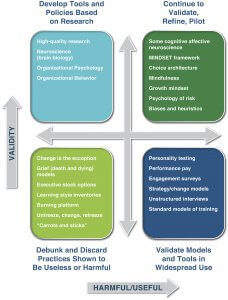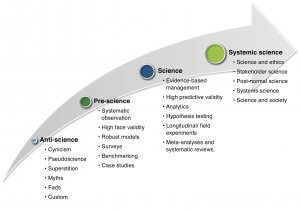I’m often asked whether change management is scientific, or whether it is pure craft? One of my main worries is about pseudoscience in society, and the business world is rife with it. Can much be done? This is an excerpt from The Science of Organizational Change – the chapter references are from that book. (You can get the book by navigating to that page on this website and I get an extra 23 cents if you buy it here.)
[social_warfare]What Is Science?
Despite my love of science, and ten years of post-high-school science education, I could not have defined science any better than Supreme Court Justice Potter’s ham-fisted definition of pornography, “I know it when I see it.” Although scientific discovery (reported by the media) surrounds us daily, and her offspring gadgets are interwoven with our lives, even trained scientists do not always understand what science is and is not.
Science is not a corpus of rigid facts about the world: There is no such thing as a scientific fact (and only lay people and the media use this term). The “facts” are really theories; some just have more evidence than others. The statement “climate change is a fact” is false; it is a very good predictive theory based upon overwhelming expertise and evidence. (Even the theory of gravity is just a theory, and while it explains apples falling from trees, it has trouble explaining certain cosmological phenomena.)
If science is not a corpus of indisputable facts, what is it? It is an experimental, social, learning process for creating and revising a specific kind of knowledge about cause and effect. It is not infallible; in fact, one of the unique things about scientific knowledge is that it is constantly being revised. The idea that science is infallible or that only science produces knowledge is called scientism —which is a charge often levelled at people who argue as I do that we need to make more and better use of it in business and in society.
The learning process we call science, is a systematic method for creating knowledge in the form of explanations and testable hypotheses. The scientific method has the following steps:
- Observe phenomena in a detailed and systematic way. Speculate about how those phenomena are related.
- Formulate a hypothesis. Create a model.
- Test whether that hypothesis makes accurate predictions.
- Revise or discard the hypothesis in the light of disconfirming observations.
As human beings, we perform Steps 1 and 2 in an unsystematic way daily, observing the world and trying to predict it: why does X happen? If Y happens, does it cause X? (In business, why are people demotivated and not engaged? If I pay them more will that motivate them? Does coaching increase motivation? If we lengthen prison sentences, do we discourage crime?)
In this way, we are full-time scientists – we observe events and people acting in certain ways, and we generate hypotheses about the circumstances that create the behavior. As an example, autism is frequently diagnosed when children are between the age of one and two, and vaccinations are often administered during the same period. This leads distressed parents to conclude (using post hoc ergo propter hoc reasoning) that vaccination causes autism. (It does not, and this turns personal tragedy into a substantial public health risk as diseases eradicated decades ago come roaring back.)
What do scientists do that human beings do not routinely do?
The Demarcation between Science and Prescience
This distinction might seem abstract, but I am going to claim that the business world is prescientific the way the natural sciences were before the Scientific Revolution 6 of the 1600s and 1700s. Every physics student learns of the Copernican revolution, which placed the Sun, and not the Earth, at the center of the Solar System. However, Copernicus did not prove any such thing. He hypothesized and proposed a model of how such a Solar System would behave, but in prescientific tradition, he left the proof for other astronomers. Proving his ideas took nearly one hundred years.
That is how prescientific (classical and medieval) great thinkers operated. They observed, had brilliant insights, dreamed up hypotheses and models, and generally made stuff up then stopped (after Step 2 of the scientific method). The idea of testing a hypothesis, using our senses and rational faculties was what was revolutionary about the Scientific Revolution. Even Aristotle developed scientific hypotheses that we know to be nonsense. For example, he believed that the function of the brain was to cool the blood, and that women had fewer teeth than men did. As philosopher Bertrand Russell quipped, “Aristotle could have avoided the mistake of thinking that women have fewer teeth than men, by the simple device of asking Mrs. Aristotle to keep her mouth open while he counted.” In those days, and up to the time of Galileo, such testing of ideas was not commonplace.
Business scholars operate just like classical and medieval scholars in their use (non-use) of the scientific method.
[social_warfare]
How Is Business Like Aristotelian and Copernican Prescience?
Take two excellent books, Kotter’s Leading Change and Christensen’s The Innovators Dilemma, as examples. Their frameworks are assembled from the authors’ (substantial) experience, intellect, scholarly attitude, and superb skills at reducing complex phenomena to their essentials. The authors perform Steps 1 and 2 of the scientific process masterfully: (1) observing and speculating, and (2) hypothesizing and model building. Where, though, is the testing and revision of hypotheses? If you cannot, or do not, test the model, how do we discriminate between Kotter’s hunches and from those of my highly paid pseudoprofessor who had yet to finish college?
For example, to prove Kotter’s Step 1, “Establish a sense of urgency,” you would have to prove that it was necessary (that change would fail without it.) I am not sure that urgency is necessary, and the notion of “burning platform” (which is the kind of urgency often discussed) is utterly harmful (as discussed in Chapter 2, “From Change Fragility to Change Agility”)
Note: I mean to point the finger at myself in this criticism. For two decades, I have talked about “burning platforms,” and “unfreezing,” and “sense of urgency” as if they were true.
Did Cisco need to create a sense of urgency when they were acquiring one company per quarter? Do each of Google’s product innovations require an injection of “urgency”? Perhaps Professor Kotter is right, about that step and the seven others, but there is no evidence other than an almost universal acceptance of the idea and anecdote. What I mean by “business is prescientific” is that we grant validity to ideas without using science to validate them. This resembles pre-Enlightenment science, more than what we understand to be science today. Pick a model, any model: Situational Leadership, Porter’s Five Forces, McKinsey’s 7-S, Theory Z management, Matrix management. How do you know their reductive simplicity isn’t misleading? How do you know they “work”? Which offer more than just anecdotal verification of their findings?
All those models are interesting ideas based on lots of observation and intuition. They were all created using Steps 1 and 2 of the scientific method, but passed on Steps 3 and 4. Some people have used them with success, some have fallen flat. However, in the prescientific paradigm, when the predictive power of theories is not tested, and little or nothing is validated scientifically, how do we discriminate truth from fiction, good from bad, and useful from harmful? We rely on “face validity” (it looks about right), the source (how famous, which business school), popularity (the New York Times best-seller list), number of tweets or followers, testimony (what our friends think about it), and perhaps even how snappy the title is (never).

Figure 1 Change leadership needs to move toward increased validity and accountability even though it will take decades.
To return to our model from the introduction (shown above in Figure 1), we have sometimes “hard-to-apply” academic research in the upper-left quadrant, pseudoscience and myth in the lower-left quadrant, and many useful yet unvalidated canonical change models in the lower-right quadrant. The project of science-based leadership is to work hard to make tools and models based on (sometimes arcane) academic research useful; to validate or discard the pseudoscience models of the lower left quadrant; to subject the commonly used models in the lower-right quadrant to much higher standards of evaluation; and to refine, pilot, and continue to validate tools in the upper-right quadrant.
Although science is not easy in complex human systems, we cannot afford to throw our hands in the air and give up. It might take decades, but it is a game worth playing and winning. It took one hundred years to prove Copernicus right (and about fifty to prove some of Einstein’s theories). The fact that models and theories are hard to prove today, with today’s research methods (and today’s attitude toward evidence in business), should not prevent us from insisting upon its importance. Much nonsense persists in the change world (such as “unfreeze, change, refreeze”) because they were introduced by someone of formidable intellect (like Kurt Lewin), and we change experts, 9 as practitioners/researchers, have been too intellectually lazy to challenge ideas from big-name sources.
Figure 2 proposes the journey to “science-based craft.” In my view, most businesses fall between levels one and two, but that many leading business are changing their culture and operating practices to ones where experimentation, hypothesis testing, and analytics drive decision making. The journey I propose, that many businesses must make, begins by first stamping out antiscience and pseudoscience.
Next section: Anti-science and pseudoscience in business
Figure 2 Evolution of a science-based craft.

Thanks for taking an interest in this article. That will give you a flavor of the final chapter – Science and Leadership. If you’d like to be kept informed of book launches, or blog posts, please don’t forget to sign up for notifications. I’d also welcome you as a subscriber to my YouTube videos.


Leave a Reply